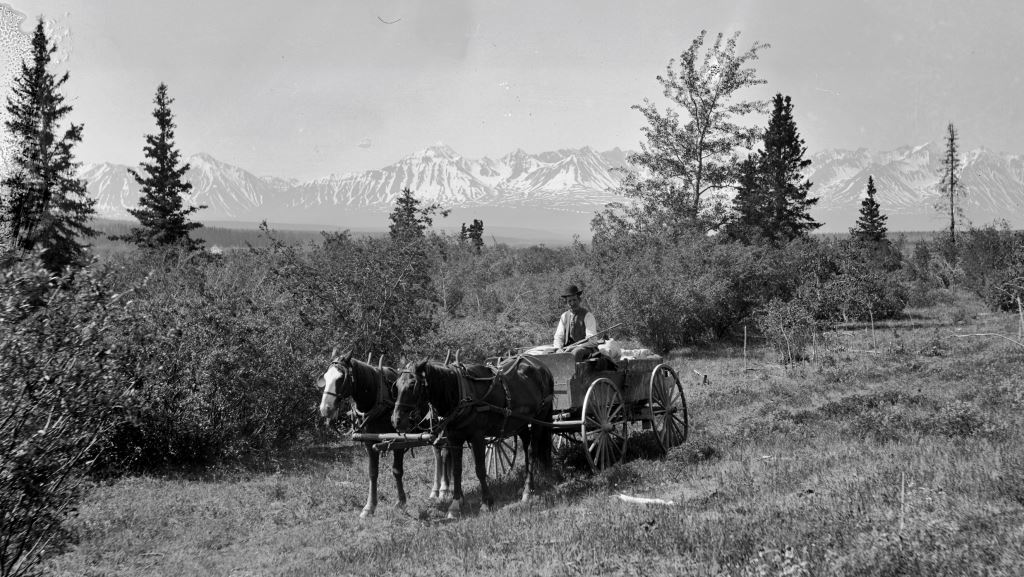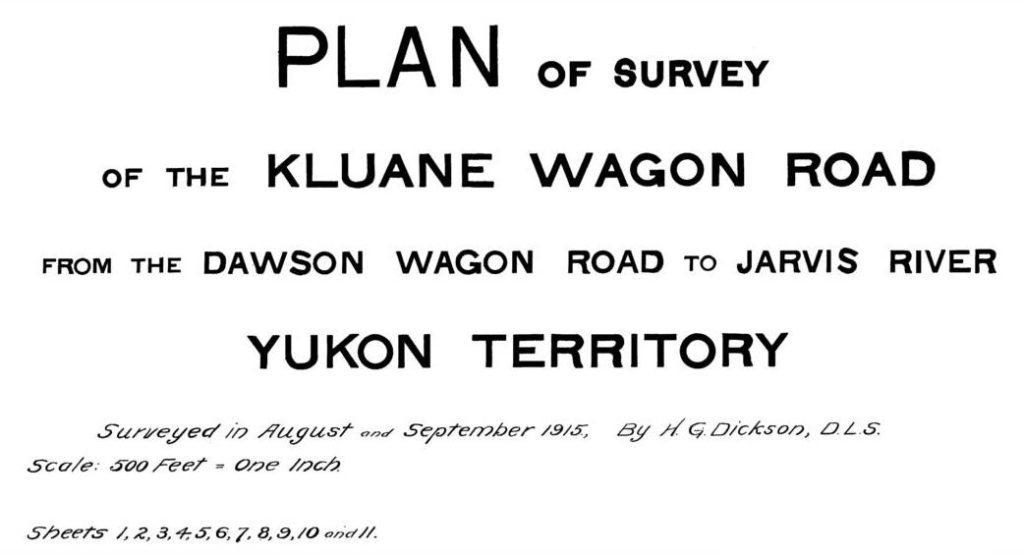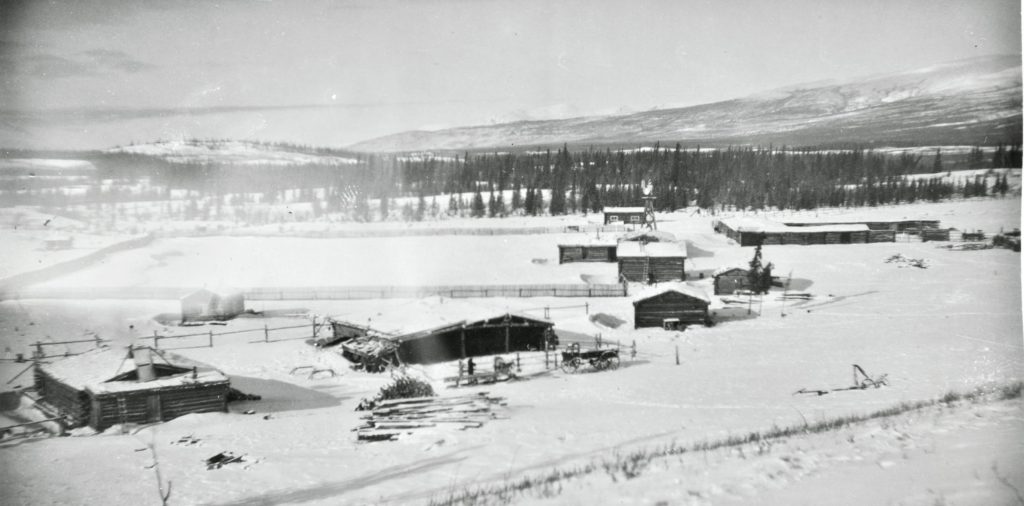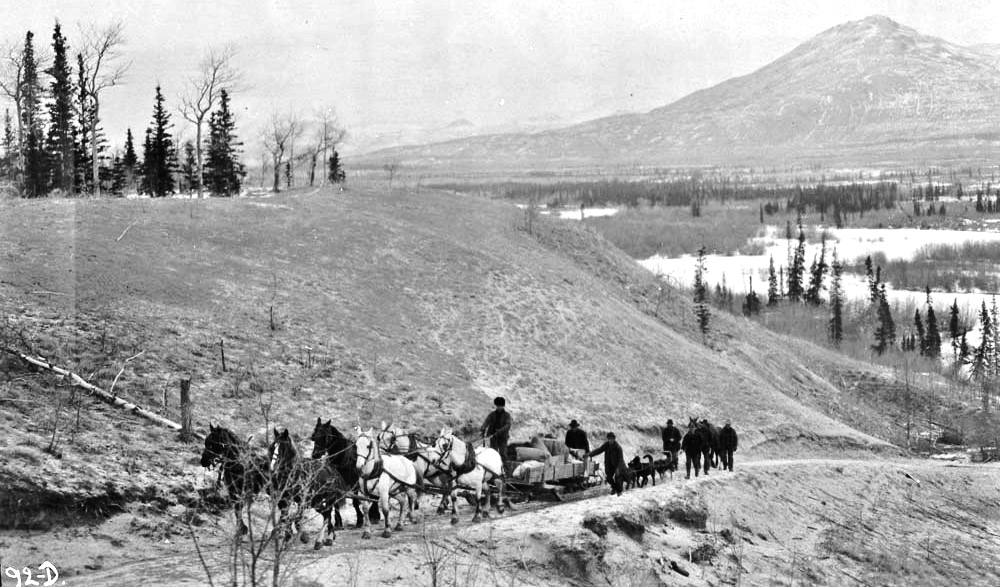The Kluane Wagon Road – part 1

Introduction
For almost 40 years before the construction of the Alaska Highway in 1942, the Kluane Wagon Road (KWR) provided the means of access to and within the southwest Yukon. The 122-mile long road was built to provide access for mining and associated activities after gold was discovered in 1903 in the creeks of the Jarvis River and Kluane Lake areas. The establishment of roadhouses, Northwest Mounted Police posts, a government office, freighting buildings and other developments followed the building of the KWR.
Over the years various locally-known old roads in the southwest Yukon have come to be referred to as the ‘Kluane Wagon Road’. While more research is needed to tell the complete story of all these roads, one route was legally surveyed under this name. In 1913 and 1915 two legal land surveys projects were carried out by a prolific and long-time Yukon surveyor named Henry G. Dickson to define the main route that had evolved during the previous decade.
I have long known of the KWR, but had never investigated it to any extent. Then a number of years ago my wife Roberta took a Yukon History course at Yukon College and chose the KWR as a research paper topic. In the course of her research she managed to obtain paper copies of the 1915 survey plan of the road, which shows it in terms of survey posts and the distances and bearings (geographic headings) between them. However, it does not show the actual location other than at a few known points along the road that had been previously surveyed.

(Canada Lands Survey Records #34678)
The information on the survey plans enables the KWR to be mapped to some degree of accuracy, but the physical remains on the land from the survey provide the real proof of the road’s location. This exists in the form of survey posts, most of them wooden, that have persisted for more than 100 years. For the past several years I have been retracing the KWR on the ground and finding survey posts that are the evidence of it.
The Imperial system of measurement, rather than metric, was in use at the time of the Kluane Wagon Road and the survey of it. For consistency and to avoid confusion, Imperial units are used in this account of the road.
Events Leading up to the Kluane Wagon Road
The southwest corner of the Yukon had been visited very little by non-First Nations people by the time gold was discovered on tributaries of the Jarvis River in the summer of 1903. The nearest ‘outsider’ activity was about 50 miles to the east, along the First Nations trading trail that ran north-south through the Dezadeash and Nordenskiold River valleys. This important trail had been taken over in the mid-1890’s by an American entrepreneur named Jack Dalton for his commercial enterprise transporting supplies, including livestock, to the Klondike goldfields.
Hints of the mining potential in the Kluane region may have prompted Harry “Shorty” Chambers, who had worked for Jack Dalton, to build a roadhouse and trading post in 1902 at the strategic location of Champagne, at the crossroads of the trading trail and the soon-to-be KWR. Chambers and his wife Annie were well positioned to provide services to travellers when Kluane area gold was discovered in 1903. A big-game hunter who visited with Chambers in 1913 wrote that “… inspired by a belief in the development of mining in this part of the country, [he] has built a large cabin for himself with many bunks for prospective travellers… And while he waits for the country to grow he hauls provisions and general supplies of all kinds from White Horse …”.

The tributaries of the Jarvis River began to attract the attention of miners in the spring of 1903 when First Nations people reported that gold could be found in that area. This coincided with the decline of the Klondike Gold Rush, as mining claims there became harder to procure and prospectors began to look further afield. The first access used by the prospectors into the Kluane area was provided by the network of foot trails that the First Nations people had made and used for ages throughout the region.
The result was discovery of gold that summer by Dawson Charlie, a co-discoverer of the Klondike gold, on a creek that he named Fourth of July for the date of the discovery. Two days later, a discovery claim was staked on nearby Ruby Creek, and others in the area soon followed. A seemingly rich gold discovery in late September on Bullion Creek near the south end of Kluane Lake further heightened the interest in mining in the region.
Things happened fast in the summer and fall of 1903 following the gold discoveries, as local infrastructure began to develop to support the mining activity. By early August the Northwest Mounted Police (NWMP) were already building a post on Ruby Creek. By the following April, four NWMP posts were established in the area, all of a portable type until it was determined if and where a permanent road to serve the region would go. A small community grew at Silver City with a NWMP post and offices for the district mining recorder and his assistant.
Newspaper reports from the early spring of 1904 talk about hauling of machinery into the area by Skookum Jim, another co-discoverer of the Klondike gold. Freighters were able to use their two- and four-horse sleds at least as far as Marshall Creek, which is 10 miles east of Haines Junction and almost 100 wagon road miles from Whitehorse. This freighting activity would have required more than a trail and occurred prior to involvement of the Yukon government in construction of the road, so evidently some early work was carried out by prospective miners to provide access suitable for their horse-drawn freight sleighs.

(Library & Archives Canada, #PA-044645)
Nice site.
Wow! Great research, writing and topics. I’ve long wondered about much of this history when wondering and exploring sites like Fort Selkirk, Pelly Farm, Silver City……… I can’t wait to read on which I’ll be doing immediately after drafting this note of appreciation. Please include me on the list for future updates to your blog. All the best to you all for 2019 and for this great project!
Marc
Thanks for the nice words, Marc. I think you might get notified by the site, but anyway I put you on my notification list as well.
What a fantastic site Gord!
I’m late to it but certainly enjoying your writing.
Hope things are well! Graham
Good to hear from you, Graham, and glad you’re liking the stories. Your feedback helps me think I’m on the right track, so thanks for that.
In this article I had said that the first gold discovery (or at least staking of a claim) in the Kluane area was by Tagish Charlie, also the co-discoverer of gold in the Klondike. The names Tagish Charlie and Dawson Charlie seem to be used interchangeably for this person, and while I thought Tagish was used most commonly, I have been advised that Dawson Charlie is the correct name. Therefore I have made this correction in the article.